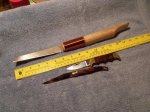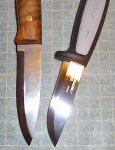Comparing puukko styles to other hunter & 'classic bushcrafter' profiles got me thinking.
There are some classic blade profiles that have very obvious designs, like skinners and sheepsfoot to avoid unwanted levels of pointy/poky/stabbyness.
What is the purpose in dropping the point down on spear, drop and clip type blades? I lack real world usage experience, so I hope you keen users could fill me in on the different purposes or any advantage specific to the point position. For example a woodlore type profile compared to a mora shape straight spine.
Cheers.
There are some classic blade profiles that have very obvious designs, like skinners and sheepsfoot to avoid unwanted levels of pointy/poky/stabbyness.
What is the purpose in dropping the point down on spear, drop and clip type blades? I lack real world usage experience, so I hope you keen users could fill me in on the different purposes or any advantage specific to the point position. For example a woodlore type profile compared to a mora shape straight spine.
Cheers.



